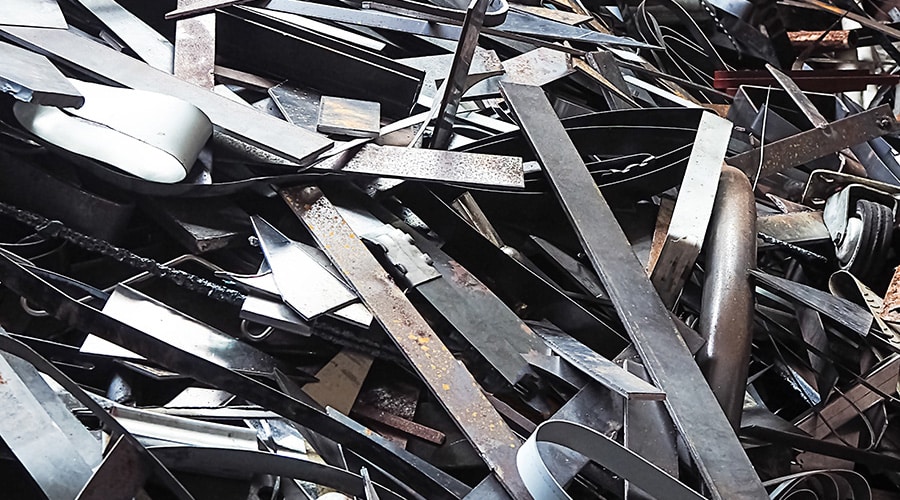Steelmakers worldwide are pursuing initiatives to manufacture more environmentally friendly “green steel.”
Government emission goals and demand from the auto industry are spurring innovation in this technology. While it is not exactly clear what constitutes green steel, and there are different approaches to try to achieve it, the pursuit of green steel will continue to increase demand for steel scrap around the world.
Steel manufacturing is one of the most energy-intensive industries, contributing about seven percent to global carbon emissions worldwide. Green steel is generally considered to be steel manufactured in a manner that cuts back on the standard level of emissions with a lower amount of carbon output in the entire process. Some observers say green steel production occurs when hydrogen made from renewable energy replaces fossil fuels to make steel. But industry experts say currently there is no strict definition or established technology.
In its “Decarbonization” series, Fastmarkets.com reports one current issue is that different regions and different industries have drastically different ideas about what green steel is, how to regulate it and how to achieve it. It has been called nebulous, or a mindset rather than a specific process, and is defined company by company.
Recycling Steel Key to Reducing Overall Carbon Emissions
The domestic steel industry points out that great strides have been made already to improve emissions in steel manufacturing. According to the American Institute of Steel Construction, in its steel mills, overall carbon emissions have been reduced by 36 percent since 1990. By weight, 81 percent of all steel products are recovered for recycling at the end of their life, including 85 percent of automobiles, 82 percent of appliances, 70 percent of containers, 72 percent of reinforcing bar, and 98 percent of structural steel. Steel is the most recycled material in the world, with structural steel currently including 93 percent recycled content. According to the World Steel Association, about 30 percent of the world’s steel is made from recycled steel scrap.
These recycling statistics are significant because using steel scrap to manufacture new steel makes huge strides in cutting emissions. Steel scrap can be processed into new steel using much lower temperatures in an Electric Arc Furnace (EAF). Steel produced using virgin iron ore requires much higher temperatures to process using a traditional blast furnace. According to the Steel Manufacturers Association, carbon emissions from an EAF reduce by 75 percent emissions from the blast furnace method. In the United States, 70 percent of steel is made from electric arc furnaces. Blast furnaces are used for the bulk of steel manufacturing in the rest of the world.
Multiple Projects Underway to Use Alternative Energy Sources
In addition to using more recycled content, a number of projects are now underway to reduce overall carbon emissions in steel manufacturing. In Colorado, the Bighorn Solar project will use a new solar farm to establish the first steel mill to get most of its power from the sun. Lightsource BP is a solar energy joint venture between BP and Xcel Energy. Xcel Energy will purchase the solar power and sell it to the EVRAZ N.A. steel mill. The project is setting up its 750,000 solar panels on more than 1,800 acres of land.
Steel produced using no fossil fuels for the first time this year was shipped to Volvo for truck manufacturing in Sweden. The Swedish consortium including steelmaker SSAB uses hydrogen in a new technology, Hydrogen Breakthrough Ironmaking Technology (HYBRIT). HYBRIT uses electricity from renewable sources to create the clean burning gas. In the process, hydrogen replaces fossil fuels. The Swedish plant producing the green steel is a pilot plant, and its goal is to be operational as early as five years from now. The production of hydrogen itself requires a significant amount of electricity, which in turn emits CO2. The success of this technology hinges on the grid supplying the electricity and whether or not it uses renewable resources like hydroelectric or solar power. SSAB says that its green steel would be 20 to 30 percent more expensive than conventional steel.
In Massachusetts, an initiative started at MIT called Boston Metal is pursuing another route to manufacture steel with lower carbon emissions. The company is working with “molten oxide electrolysis,” a process in which electricity is run through melted iron oxide to produce steel and oxygen.
More and Better Recycling Can Help Meet Emission Goals
For all of these and several similar projects, massive investments are needed to implement new technology. In the end, costs will be passed to consumers of premium green steel. Evaluating and implementing these investments will take years, industry experts say, because of the long investment cycles in the very capital-intensive steel industry. On a Resources Radio podcast last year, an expert in industrial decarbonization clarified the point that because green steel will be expensive to produce, increased recycling can help meet emission goals. He said, “The first and foremost thing is to do more, better recycling…The more you (improve recycling protocols) the more that iron becomes endlessly recyclable within our economy, and it means less iron ore has to be processed with greenhouse gas-intensive processes.”
ScrapWare Corp., of Rockville, MD, has been providing software to the scrap metal recycling industry for over 30 years. ScrapWare uses an Oracle database to provide a cloud-based software solution to manage all aspects of a recycling business. With numerous modules, extensive technical support, remote installation and online training, ScrapWare helps recycling companies with compliance, efficiency and profitability. Check out ScrapWare’s website, read the user testimonials, and see its offerings for your recycling software solution.

